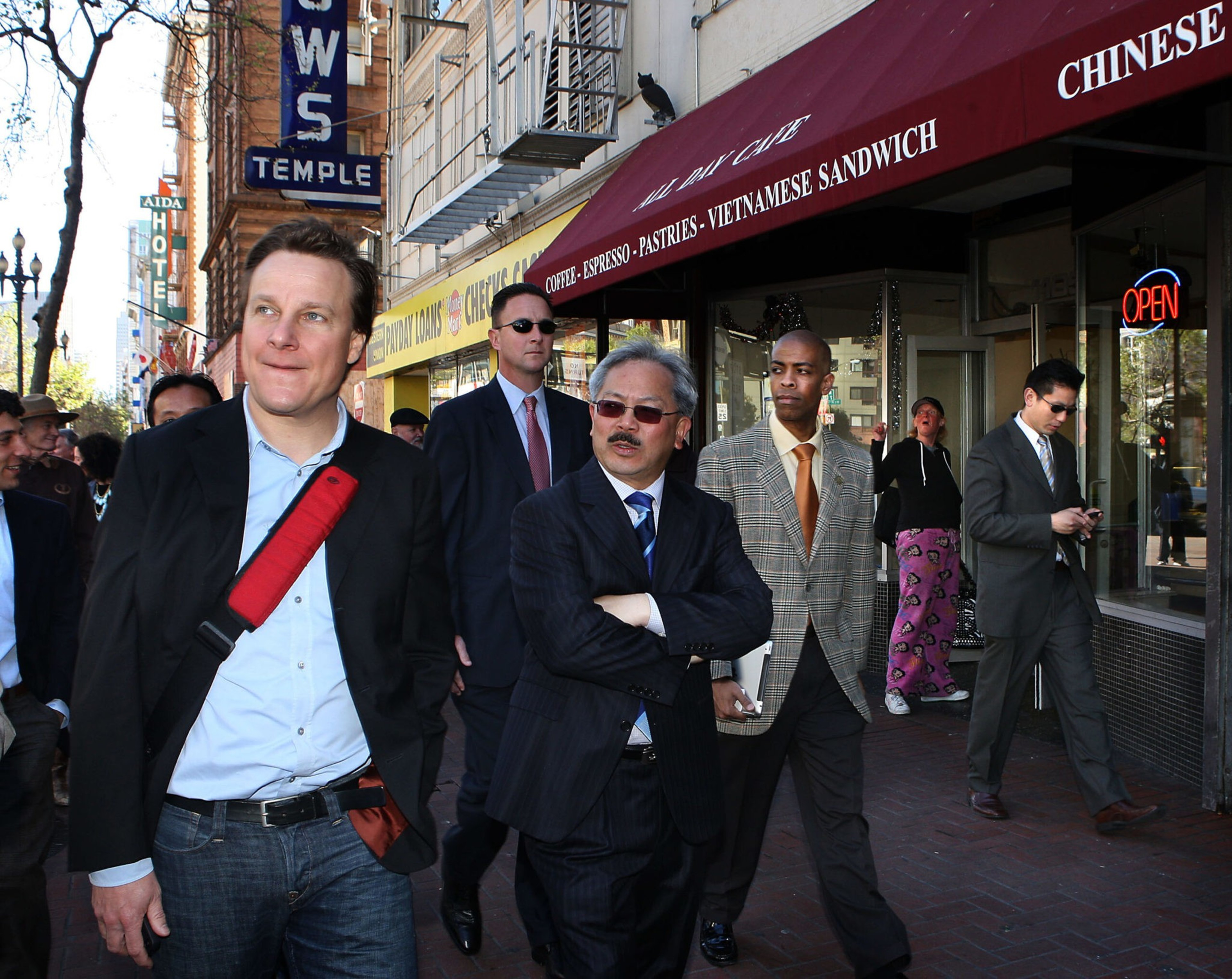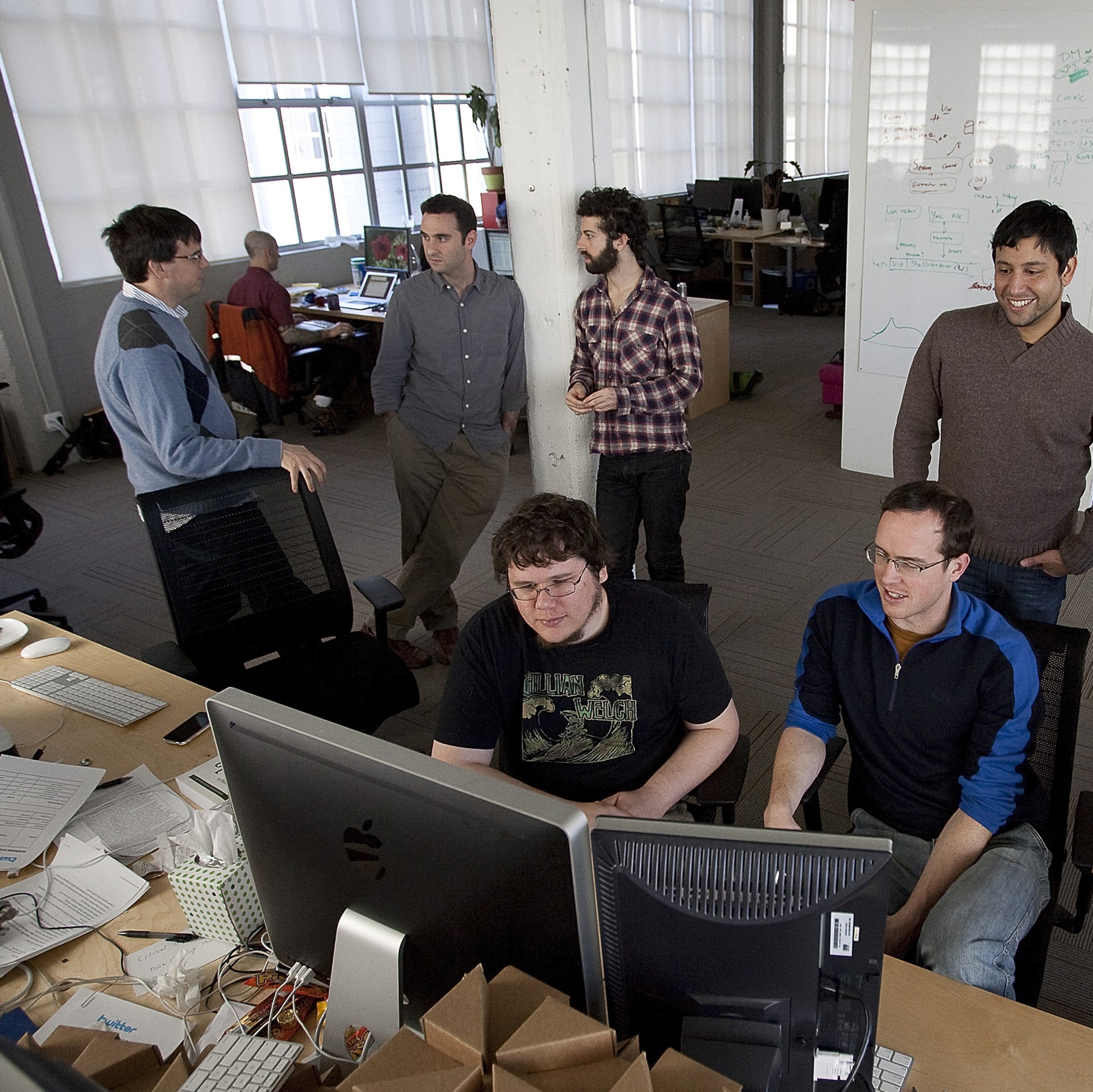The corner of Market and 10th streets, smack-dab in the heart of San Francisco’s main business district, was for many decades a forlorn cityscape of half-empty buildings, struggling storefronts and troubled people living on the streets.
Soon a transformation was underway: The dilapidated Fox Plaza was renovated; luxury apartment towers sprouted to serve the new workforce; retailers and fellow tech firms flowed into neighboring buildings. Sales tax revenue in the two zip codes that include Mid-Market rose from about $30 million in 2010 to nearly $42 million in 2019.
Much of that changed rather abruptly in 2011, when a tax break for companies that moved to the Mid-Market neighborhood landed Twitter—then a startup with lofty dreams of democratizing speech—in a hulking former furniture showroom at 1355 Market St.
The boom times created new problems around displacement and gentrification, but the city’s bet on incentives was a success—at least by its own standards. Twitter and its cohort helped pave the way for a parabolic tech boom that turned SF into one of the wealthiest cities in the world.

Recent visitors to the area, however, might get a feeling of deja vu. Neighboring tech giants, including Block, the fintech firm started by Twitter cofounder Jack Dorsey, have fled the city altogether. Uber, another mainstay of Mid-Market, decamped for a new location in Mission Bay.
The challenges—and the opportunities—facing Mid-Market are a microcosm of what SF is facing as the tech tidal wave that swept the city abruptly recedes. Twitter, which once proudly proclaimed (opens in new tab) itself the “free speech wing of the free speech party,” has instead been mired in political controversy and unable to find financial stability.
The roughly 2,000 “Tweeps” who once worked at Twitter’s headquarters complex have largely vanished since the company offered permanent remote work in May 2020. And now, with Twitter on the cusp of a drama-plagued buyout deal that could result in major layoffs, the struggling neighborhood’s future looks more uncertain than ever.
Its likely new owner, the capricious billionaire Elon Musk, is planning to gut the company: He’s been telling investors he plans to slash nearly 75% of the company’s staff of 7,500 to boost profits and cut costs, according to The Washington Post. The development is just the latest crisis in what has been a wildly chaotic era for the company.
The immediate outlook for the neighborhood is bleak. A rundown of the large office buildings in Mid-Market reads more like a list of Who’s Left rather than a Who’s Who; offices may empty out further as leases signed by Block, Uber, Airbnb and DoorDash expire over the next few years. While there’s some countercyclical investment by developers betting on a rebound, it’s nothing like the money that was flowing in just a few years ago.

For its part, Twitter has consolidated its entire San Francisco office holdings into its 1355 Market St. location, where it currently occupies 379,000 square feet. That lease currently is set to expire in 2028; through a spokesperson, Twitter said that it does not disclose geographic breakdowns of its employees, but that it remains “committed to the market.” But that was before the recent revelations about Musk’s downsizing plans.
Bust to Boom
The neighborhood was in a similarly tenuous state back in 2011, when the Board of Supervisors, looking to revitalize the long-troubled Mid-Market corridor, voted to eliminate the 1.5% payroll tax for companies that set up shop in the area. At the time, the Great Recession had left around half the neighborhood’s offices and 30% of its retail shops empty.
Twitter was on the precipice of a move to the Peninsula when the tax break—officially called the Central Market/Tenderloin Payroll Tax Exclusion—passed. Politically connected real estate firm Shorenstein Partners purchased the vacant wholesale furniture store for $89 million in an off-market sale that was brokered in part by city officials, and then spent millions renovating the space for the arrival of new, creative tech tenants. Shorenstein sold off the majority (opens in new tab) of its stake in the building and the neighboring 875 Stevenson St. for $900 million in 2015, according to PropertyShark.
“What we had back then is that we had a pretty cool city that young engineers wanted to live in, and at that time, we were still affordable and still safe, at least more so than we are now,” said Wade Rose, president of business advocacy group Advance SF.

With the influx of tech workers came retail and residential development, along with hallmarks of gentrification like trendy fusion restaurants and hipster cafés.
That success was accompanied by a ferocious backlash as housing costs spiked and exacerbated a new class divide that emerged in the city. Meanwhile, community benefits like grants, social services and streetscape improvements meant to be provided by the companies largely failed to materialize.
Toil and Trouble
Meanwhile, Twitter fell into its own struggles: After riding a wave of social media hype to a 2013 IPO, it never found a reliable business model and has turned a profit only occasionally. Its C-suite turned into a revolving door amid boardroom turmoil and feuds (opens in new tab) among the social network’s founding team.
Early fanfare around the platform’s potential to fortify democracy around the world (opens in new tab)—thanks in part to the Arab Spring protests that began in 2010—turned sour as bots and disinformation flooded the site.
Internally, the company lurched from controversy to controversy ranging from high-profile hacks (opens in new tab) to its embrace by former President Donald Trump, who used his account to attack adversaries and stoke a bloody insurrection on the U.S. Capitol building before his permanent ban on Jan. 8, 2021. And the company’s strong ties to the liberal bastion of San Francisco, along with its “more left-leaning” employees, (opens in new tab) have made it a favorite whipping post for Trump and his right-wing political allies.

Longtime neighborhood denizens point out that the promise of the “Twitter tax break” was never fully realized. The arrival of techies and hip coffee shops couldn’t cure the area’s poverty, homelessness and drug issues—all exacerbated by the pandemic.
“Mid-Market was probably on a bad trajectory before 2020 because it felt like the city had moved on to some of its other problem children,” said Christopher Graves, owner of Littlejohn’s Candies at 1422 Market St. and a resident of the area for more than 20 years. “I love grit, but this ain’t grit anymore, it’s needles and poop.”
Phillip Ma, the co-owner of Dough, a pizza shop on the ground floor of 1455 Market St., has weathered economic storms since first opening up shop in 2005. He said the area is the worst he’s ever seen it.
During a pre-pandemic peak, Ma and his wife operated three locations in and around Mid-Market: Dough, Homeskillet and Mavelous Coffee Bar & Little Griddle. Now only one remains.
“If you look outside, you see a trickle, a few people here and a few people there. It’s better than the beginning of the pandemic, but it still looks dead to me,” Ma said.
At Musk’s Mercy
Enter Musk, a self-described “free speech absolutist (opens in new tab),” who offered a $44 billion bid for the company before attempting to renege on the offer. After an acrimonious legal fight, Musk proposed to buy the company at its original price on Oct. 5.
Many in the neighborhood believe that Twitter’s days in San Francisco are numbered if Musk, who has spoken disparagingly of the Bay Area (opens in new tab) and who himself decamped for Texas, takes over the company. Even before Musk’s bid, Twitter’s management reportedly had already laid plans to shave some $800 million from the company’s payroll. (opens in new tab)

“I don’t know what’s next, but we’re definitely at the end of this boom,” Ma said. “You’re seeing all these tech companies basically follow Elon out of the state, and I’m sure if he bought Twitter, he’d move it, too.”
It’s thrown the neighborhood back into a state of flux—and may force yet another reinvention as the city attempts to forge a post-tech, post-pandemic path.
City officials are trying to improve the street conditions, in part by investing in ambassador programs focused on the Tenderloin and Mid-Market to help make the streets safer and cleaner. Reviews are mixed on their impact. Daniel Partridge, director of operations at the bank-turned-event-space Hibernia at 1 Jones St., said that his business remains heavily reliant on its own resources for that work.
A combination of security and regular cleaning—Hibernia pressure washes its building and perimeter on average three times daily—have brought back tours and events to the space, said Partridge.
“It all feeds into some of the revitalization of the neighborhood that we’re really, really hoping for,” Partridge said. “We’re bringing in 600 people to the area that don’t typically spend time down here.”
Some city supervisors are kicking the tires on another round of tax breaks or incentives to jumpstart business activity. District 6 Supervisor Matt Dorsey, who represents the Mid-Market area, said he’s “opened the hood” on the idea. But with remote work now entrenched in many tech firms, there’s skepticism that a tax break would do much good.
“What I heard is that it probably won’t make a difference,” Dorsey said. “Because of how tech-centric we are, [remote work] has basically become a work benefit, and people will go work somewhere else if their company says they’ve got to come in.”

Even with nearby offices empty, there are those moving ahead with major bets. Australian developer Lendlease recently broke ground on Hayes Point, a self-financed $1 billion office and condo project at 30 Van Ness Ave., a stone’s throw from Twitter’s headquarters building.
“We know when we invest now … and deliver in 2025, we have literally zero direct new competition on the office side, and the same is true on the residential side as well,” said Arden Hearing, executive general manager of West Coast development for Lendlease.
A nearby 502-unit luxury apartment building, which opened in July 2021 as part of the Trinity Place development, reached “over 95% occupancy” this month according to Trinity vice president Shadd Newman.
Newman said the neighborhood’s central location and easy transit access still make it desirable for residents. His vision is predicated on the Mid-Market neighborhood evolving into a real place to live, work and play rather than a 9-to-5 outpost for commuters.
There are some flickering signs of life on that front. The Line SF, a trendy hotel at 33 Turk St., opened its doors last month and includes a new fine dining restaurant, the only Bay Area outpost of buzzy café Alfred Coffee. A rooftop bar is slated to open in the coming weeks.
But some of those who have long been invested in Mid-Market still believe they, too, have a role to play in the neighborhood’s next act.
“I’m optimistic about this area that’s going to change for the better. This corridor is going to be a landmark, a gateway to San Francisco,” said Ma, the pizzeria owner.
At least he hopes so: Ma’s business still has around two decades left on its lease.